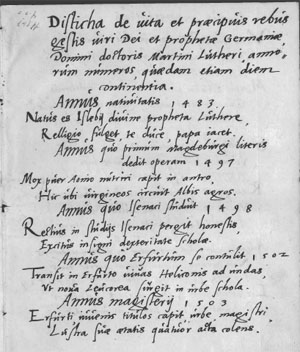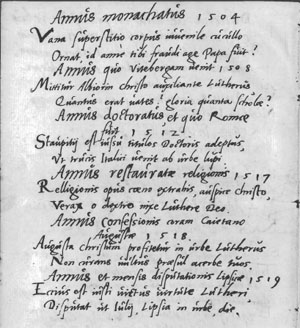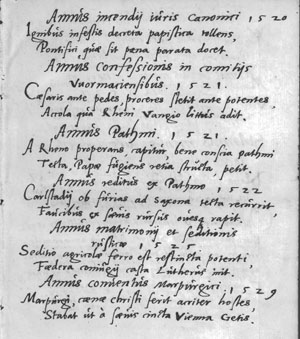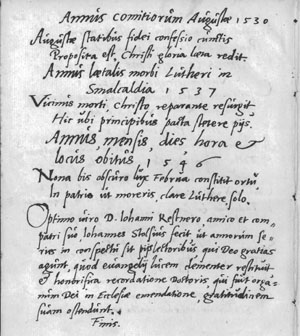Home
» Special Collections » Digital Collections » Johann Stoltz Papers (MSS 089)
Johann Stoltz Papers (MSS 089)
Johann Stol(t)z was a Lutheran Theologian and protege of Martin Luther. He was born ca. 1514 in Wittenberg, Germany. After finishing his studies at Wittenberg University in 1539, he served as deacon of Jessen and as tutor to August (later elector of Saxony). In 1540 Stoltz received a stipendium from Luther's intermediary that allowed him to return to Wittenberg to study during the winter course of 1540-1541. In 1544 he served as a professor at Wittenberg.
Following the death of Martin Luther in 1546 Stoltz joined with Nikolas von Amsdorf, Matthias Illyricus Flacius and other "faithful Lutherans" to oppose the Interim. In 1547 while serving as Weimar court preacher he wrote the Weimar response against the Interim. During his service at Weimar Stoltz developed a keen interest in Church government. He was deeply involved in the Synergistic Controversy that arose following the Leipzig Interim of 1548. In 1555 Johann Pfeffinger formulated his Melanchthonian theses on Free Will. In 1556 Stoltz countered with his 110 theses and was supported by Amsdorf and other "faithful Lutherans." Stoltz also assisted in the compiling and editing of the (University of) Jena Edition of the Works of Martin Luther.
Twenty distichs (couplets) inspired by important events in the life of Martin Luther. The couplets, in Latin, were composed ca. 1550 and are written on paper. The author's name is found at the end of the piece as is his dedication of it to Johann Kestner. Pencil markings of a later owner are located in the upper left corner of the first page. Originally part of a signature, each of the two leaves has been encapsulated in mylar for protection.
The images below are available in PDF format.
|
Page 1:
|
|

|
Translation:
Distichs on the Life and Most Notable occurrences of that Man of God and Prophet of Germany Master Doctor Martin Luther in chronological order containing sometimes even the dates by number of those events. The year of his birth is 1483. You are born in Eisleben, O divine prophet Luther. Brightly religion lights you, as the Pope falls. The year he first began in Magdeburg his study of letters is 1497. Soon the boy from all his nurses is reaching for the stars, Here where he wanders about the large Alban fields. The year he began to study in Eisenach: 1498. In Eisenach the upright man pursues his studies; There he shows himself to be gifted with superior ability. The year he went to Erfurt: 1502. Over to Erfurt, to the shores of the living Helicon, To attend the new school, the Leucorea, in the city founded. He got his Master's Degree in 1503. The young man took his degree of Master in the city of Erfurt Cultivating the Four Arts the glories of his age.
|
|
Page 2:
|
|

|
Translation:
He enters the Monastery in 1504. With but vain superstition the monk covers with a cowl his head; That was what you caused him to do with fraud, o pope! The year he came to Wittenberg: 1508. Luther is sent to Wittenberg with Christ's assistance; How fateful that was; how glorious was that school. The year of his doctorate and when he went to Rome was 1512. The order was from Staupitz to take the doctoral degree; To go to Italy to meet the cruel wolf. The year of the restoration of religion was 1517. You draw out the work of religion from the Supper with the help of Christ; Turn, O good God, Luther to the right path. The year of the noble confession before Coyetan was 1518. Luther confesses Christ in the mighty city; He is not fleeing your savage mobs. The year and the month of the Leipzig Disputation is 1519; Eck is justly vanquished by the virtue of Luther; They disputed in the City of Leipzig on that day in July.
|
|
Page 3:
|
|

|
Translation:
The year of the Burning of the Canon Law is 1520. With savage flames the decrees of the popes are carried away, teaching the Papists what punishment is in store for them. 1521: The year of the Confession at the Diet of Worms. Before the feet of mighty Caesar his minions abject grovel at Acrola, on the shores of Rhenish Vangia. 1521: The year of Patmos. Leaving the Rhine he is captured and with good conscience sent to Patmos seeking a well-built house, fleeing the wrath of the Pope. 1522: Year of the return from Patmos. Because of the furies of Carlstadt he returns to his Saxon home; with his fists he rescues the sheep from the savage beasts. 1525: Year of his marriage and rustic settlement. Rustic seclusion is scarcely a restraint to a powerful man. Luther enters the solemn bonds of matrimony. 1529: Year of the Colloquy of Marburg. At Marburg the enemies of the Supper of Christ attack furiously. He stands against the savage imperials of all Vienna.
|
|
Page 4:
|
|

|
Translation:
1530: The year of the Augsburg Confession. At Augsburg before all the nobles the Confession of faith is proposed, and the glory of Christ is again revealed. 1537: The year Luther, near death, goes to Smalkalden. Near to death yet by Christ again healed he comes here, where the pious princes make up their treaty. Year, month, day, hour, and place of his death in 1546. At two in the afternoon the February light lightens the place in your homeland where you are dying, O Luther, alone. To that best of men D. Johannes Kestnerus, his friend and co-patriot Johannes Stolsius, who made this series of verses to show his love to his pious readers who give thanks to God for the light of the Gospel which God has graciously restored, and for the sake of honoring the Doctor [Luther] who was a tool of God for the building up of His Church, and hereby he makes testimony of his gratitude. The end.
|
For additional information about this collection, consult the finding aid.




